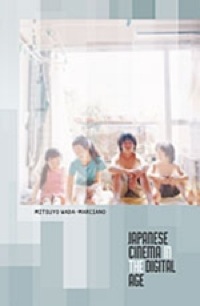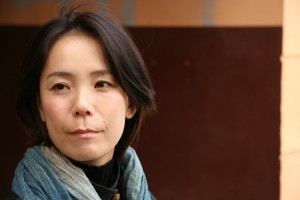J-Film Goes Global
 Anime, J-horror, and Japanese personal documentary and “ethnic cinema” have gone global, and that’s in good part due to the advent of digital technology.
Anime, J-horror, and Japanese personal documentary and “ethnic cinema” have gone global, and that’s in good part due to the advent of digital technology.
So writes Mitsuyo Wada-Marciano in Japanese Cinema in the Digital Age, just out from the University of Hawai’i Press. The associate professor of film studies at Carleton University in Ottawa explores the role of globalization in the mainstreaming of Japanese film as an example of “convergence culture” and its role in mingling the flows of global economics and culture. Digitization, she suggests, has transformed cinema’s production, distribution, and consumption patterns. It has revitalized a once-moribund industry with regional genres such as anime and Japanese horror that now challenge Hollywood’s preeminence. She also suggests that, despite the convergence of cinema cultures, where transnational culture has become a form of cosmopolitanism, national production remains key to innovations. She draws on interviews with such directors as Kore’eda Hirokazu, Kurosawa Kiyoshi, and Kawase Naomi, and challenges the assumption that Hollywood’s is the only “global” cinema.
 Wada-Marciano’s earlier books were Nippon Modern: Japanese Cinema of the 1920s and 1930s (University of Hawai’i Press, 2008) and, as co-editor, Horror to the Extreme: Changing Boundaries in Asian Cinema (Hong Kong University Press, 2009). She is currently at Kyoto University conducting research for a book on the cinema in post-Occupation Japan, 1952-1960.
Wada-Marciano’s earlier books were Nippon Modern: Japanese Cinema of the 1920s and 1930s (University of Hawai’i Press, 2008) and, as co-editor, Horror to the Extreme: Changing Boundaries in Asian Cinema (Hong Kong University Press, 2009). She is currently at Kyoto University conducting research for a book on the cinema in post-Occupation Japan, 1952-1960.
Mitsuyo Wada-Marciano answers some questions about her research
Was it difficult to find the films needed for your book project?
My book targets films from the end of the studio period (which ended arguably in the late 1980s) to the present. Therefore, many of the films, especially produced after 1996, the year when DVD became accessible to general consumers, are relatively easy to purchase in the DVD form. Compared with my previous book on the 1920s and 1930s cinema, Nippon Modern (2008), I had less difficulty this time to find the films I wanted to view. But rather the difficulty was that there are too many films/DVDs to choose from. I wanted to elaborate the tendency in popular genre films, such as “J-horror” or “anime,” to be distributed and consumed via multiple platforms, not only through theaters. I simply needed to watch literally anything in the video stores, like the Japanese franchise TSUTAYA. It was a luxurious burden to select a few films from so many to thoroughly analyze for each chapter. One side benefit was I acquired a substantial amount of content for teaching updated courses on contemporary Japanese and even other East Asian films.
Were you able to access good archives for your project, and can you tell us a little about them?
As academic writing tends to be slower than journalistic writing, the major film archives are not keen to collect the contemporary films in Japan. That is why I decided to meet the filmmakers and have interviews instead. They made their films available for me in digital form. Once I established trust with them, they were willing to let me view their as yet unreleased works. Director Kore’eda Hirokazu, for instance, started his career as a documentary maker for television, and his documentaries are not widely accessible. Therefore, I asked to view them during my interview with him. I did the same with another director Kawase Naomi, when I visited her office in Nara, Japan. My ideas about her documentary Tarachime (2006) came to me while watching it with her manager, Sakamoto-san, in her office. It is something of a paradox that the interviews with filmmakers often revolved around practical matters of filmmaking, which were of little use to my book. However, in an indirect fashion the process sometimes gave me unexpected insights. As for animation, I was able to find many texts available at YouTube and/or Nico Nico Douga, and I am sure there are more video sharing websites that I am not aware of.Anything else archives-related come to mind? In the case of your book, perhaps you had unusual or telling experiences searching Japanese archives that you could relate?
I think if I may talk about my current book project on the post-Occupation cinema in the 1950s, I could probably elaborate more on the aspects of searching Japanese archives. My research schedule usually begins at the National Film Center in Tokyo to find out if they have the films available for viewing. The center’s homepage has the search engine for the film database. The downside of the film archive is that viewing films there is quite expensive. If you are affiliated with any Japanese universities or equivalent educational institutions, you can get a fifty percent discount, but if you are from outside Japan, you need to pay the full amount, which is approximately US$125 per hour. You must also book your screening at least three weeks in advance, since they need to bring the films from their preservation branch in Sagamihara. I, therefore, often end up searching alternative archives such as The Museum of Kyoto, Tokushima Prefectural Archive, International Research Center for Japanese Studies in Kyoto, and Waseda University Library. As for printed media, books and film journals in Japanese, I often go to The Tsubouchi Memorial Theater Museum at Waseda University, where the price of copying is still reasonable and extensive printed materials are available. The Theater Museum is nice and open to public.
I imagine that digitization has changed the nature of availability, but are Japanese producers well organized when it comes to archiving and research access?
To my knowledge, neither producers nor even film companies such as Toho, Shochiku, and Toei, are interested in archiving or making their films accessible to researchers in Japan. Although they are very keen to protect their content properties, this is all for making profits. I have been working as a specialist of Japanese cinema and visual culture for more than a decade, and yet I have had very little contact with producers and film companies. The only exception was a producer in Shochiku Co., Yamamoto Ichiro, who had worked as a producer of Hou Hsiao-Hsien’s films.
Previous Post: Instant Cinema: Experimental Media Art Online
Next Post: J-Film Goes Global








